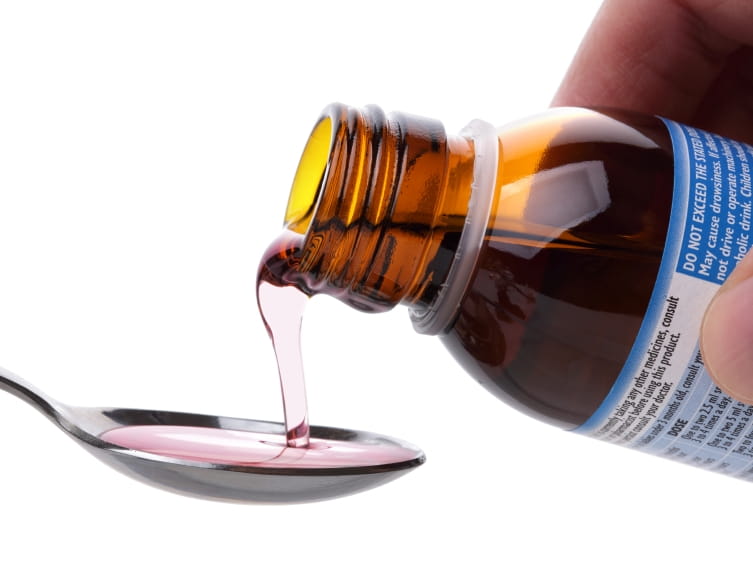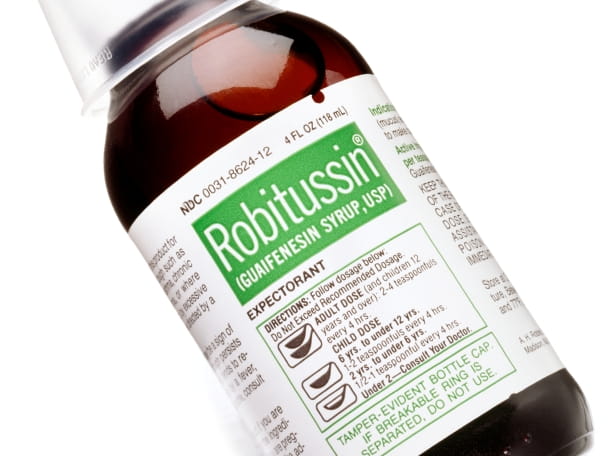Dextromethorphan Abuse

The Bottom Line
Dextromethorphan is an over-the-counter cough suppressant found in more than 120 cough and cold products. Recreational abuse has become increasingly common and leads to approximately 6000 emergency room visits a year. Recreational users intentionally exceed recommended doses to experience heightened awareness, altered time perception, and visual hallucinations.

The Full Story
When used at the dosage printed on the product label, dextromethorphan (DXM) is a fairly safe drug intended to reduce coughing. Although there is controversy about its effectiveness as a cough suppressant, the effects of DXM at high doses are well documented. At high doses, DXM can produce psychedelic symptoms including mania, panic, extreme agitation, and hallucinations. Dextromethorphan poisoning can also cause slow breathing, fast heart rate, increased blood pressure, psychosis (losing contact with reality), seizures, coma, and death. When DXM is abused regularly it can actually cause symptoms that are the opposite of the user’s intent such as insomnia and dysphoria (unease, unhappiness). DXM abuse goes by many slang names including "dexing," "robodosing," "robofizzing," "robotripping,"and "skittling".
Adding to the danger is that DXM is often taken in combination with other drugs. The interaction between DXM and drugs such as alcohol, acetaminophen, and other OTC cough and cold medicines can be highly toxic.
How did dextromethorphan become so readily available? DXM was approved by the Food and Drug Administration (FDA) in 1958 and was deemed a safe and effective cough suppressant. Recreational abuse of DXM-containing products began shortly thereafter. In 2005, the FDA issued a warning regarding DXM abuse to increase awareness of this growing trend. This warning was in response to reports of deaths of teens that were related to the use of raw DXM purchased over the Internet.
In 2009, the National Institute on Drug Abuse's Monitoring the Future Survey found that 6% of high school seniors had abused DXM. DXM abuse leads to approximately 6000 emergency room visits each year with half due to abuse by those aged 12 to 25 years. Many manufacturers of cough and cold products containing DXM have included warnings and information on their product websites to increase awareness about the dangers of DXM abuse.
There are websites that claim to offer DXM powder for sale, provide instructions on the extraction of DXM from OTC products, and abusers' descriptions of their "trips". These websites should not be trusted.
Recreational DXM use might not be widely appreciated because DXM has legitimate uses and is not thought of as a drug of abuse, making it difficult to assess the public health impact. Data on patterns of drug abuse usually come from reports from Poison Control and emergency physicians. Calls to Poison Control regarding DXM have increased dramatically since 2006.
If you suspect someone has taken too much dextromethorphan, immediately check the webPOISONCONTROL® online tool for guidance or call Poison Control at 1-800-222-1222.
Mary Elizabeth May, RN, BA, MPH, CSPI
Certified Specialist in Poison Information
Poisoned?
Call 1-800-222-1222 or
Prevention Tips
- Talk to children and teenagers about the dangers of cough medicine abuse.
- Warn teens and young adults that mixing dextromethorphan (DXM) with alcohol or other drugs is extremely dangerous.
- Be aware of slang terms for DXM abuse.
- Watch for warning signs of DXM abuse such as loss of interest in activities or hobbies, empty cough and cold medication containers, declining grades, and medicinal smells.
- Watch for symptoms that could be related to DXM poisoning such as loss of coordination, slurred speech, dizziness, hallucinations, and agitation.
- Dextromethorphan is NOT just in cough syrups. There are many tablet products that contain DXM along with other drugs that could be dangerous in overdose.
This Really Happened
Case 1: Two boys, aged 17 and 19 years, found a way to purchase dextromethorphan powder over the internet. The boys had previously experimented with DXM for recreational use many times. They started out by abusing OTC cough and cold products, and their usage increased to the powder formulation. They were found dead at the 17-year-old’s home after a sleepover. A clear plastic bag of white powder labeled "dextromethorphan HBr (hydrobromide) 100 grams, not for human use" was next to the bodies. The cause of death in both cases was determined to be acute DXM poisoning.
A law enforcement investigation determined that the boys also repackaged DXM powder into gelatin capsules purchased at a health food store in order to sell it to others in their high school. At least three nonfatal overdoses resulted from the repackaged DXM, two of which required ER treatment.
Case 2: A 16-year-old girl went to the nurse’s office at her school complaining of not feeling well and vomiting. She finally admitted to taking 16 tablets of an OTC combination cough and cold product containing DXM that morning. She was transported to an ER where she told an emergency physician that she was just trying to treat a cold. The emergency physician contacted Poison Control and was given information on the toxicity and treatment of DXM poisoning. The patient appeared drowsy and her heart rate was increased. She was given intravenous fluids. Once her mental status and vital signs were normal, she was sent home with a referral for outpatient drug abuse counseling.
For More Information
WebMD video, Teen Abuse of Cough and Cold Medicine
Learn the Facts about Drugs: Just Think Twice (tragic and true stories of teens who have overdosed)
References
Chary M, Park EH, McKenzie A, et al. Signs & symptoms of dextromethorphan exposure from YouTube. PLoS ONE. 2014;9,:e82452.
Gershman JA, Fass AD. Dextromethorphan abuse: a literature review. J Pharm Technol. 2013;29:66-71.
Logan BK, Goldfogel G, Hamilton R, et al. Five deaths resulting from abuse of dextromethorphan sold over the internet. J Anal Toxicol. 2009;33:99-103.
Reissig CJ, Carter LP, Johnson MW,et al. High doses of dextromethorphan, an NMDA antagonist, produce effects similar to classic hallucinogens. Psychopharmacology (Berl). 2012;223:1-15.
Stanciu CN, Penders TM. Mania after misuse of dextromethorphan: a case report and brief review of “robotripping.” J Addict Med. 2015; 9:159-60.
Wilson DW, Ferguson RW, Mazer ME, et al. Monitoring trends in dextromethorphan abuse using the National Poison Data System: 2000-2010. Clin Toxicol (Phila). 2011;49:409-15.
Poisoned?
Call 1-800-222-1222 or
Prevention Tips
- Talk to children and teenagers about the dangers of cough medicine abuse.
- Warn teens and young adults that mixing dextromethorphan (DXM) with alcohol or other drugs is extremely dangerous.
- Be aware of slang terms for DXM abuse.
- Watch for warning signs of DXM abuse such as loss of interest in activities or hobbies, empty cough and cold medication containers, declining grades, and medicinal smells.
- Watch for symptoms that could be related to DXM poisoning such as loss of coordination, slurred speech, dizziness, hallucinations, and agitation.
- Dextromethorphan is NOT just in cough syrups. There are many tablet products that contain DXM along with other drugs that could be dangerous in overdose.
This Really Happened
Case 1: Two boys, aged 17 and 19 years, found a way to purchase dextromethorphan powder over the internet. The boys had previously experimented with DXM for recreational use many times. They started out by abusing OTC cough and cold products, and their usage increased to the powder formulation. They were found dead at the 17-year-old’s home after a sleepover. A clear plastic bag of white powder labeled "dextromethorphan HBr (hydrobromide) 100 grams, not for human use" was next to the bodies. The cause of death in both cases was determined to be acute DXM poisoning.
A law enforcement investigation determined that the boys also repackaged DXM powder into gelatin capsules purchased at a health food store in order to sell it to others in their high school. At least three nonfatal overdoses resulted from the repackaged DXM, two of which required ER treatment.
Case 2: A 16-year-old girl went to the nurse’s office at her school complaining of not feeling well and vomiting. She finally admitted to taking 16 tablets of an OTC combination cough and cold product containing DXM that morning. She was transported to an ER where she told an emergency physician that she was just trying to treat a cold. The emergency physician contacted Poison Control and was given information on the toxicity and treatment of DXM poisoning. The patient appeared drowsy and her heart rate was increased. She was given intravenous fluids. Once her mental status and vital signs were normal, she was sent home with a referral for outpatient drug abuse counseling.
